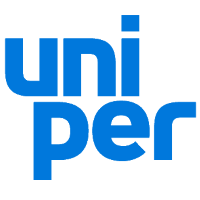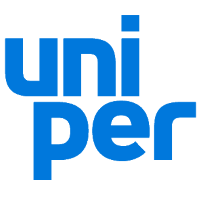
Uniper SE
XETRA:UN01


| US |

|
Johnson & Johnson
NYSE:JNJ
|
Pharmaceuticals
|
| US |

|
Berkshire Hathaway Inc
NYSE:BRK.A
|
Financial Services
|
| US |

|
Bank of America Corp
NYSE:BAC
|
Banking
|
| US |

|
Mastercard Inc
NYSE:MA
|
Technology
|
| US |

|
UnitedHealth Group Inc
NYSE:UNH
|
Health Care
|
| US |

|
Exxon Mobil Corp
NYSE:XOM
|
Energy
|
| US |

|
Pfizer Inc
NYSE:PFE
|
Pharmaceuticals
|
| US |

|
Palantir Technologies Inc
NYSE:PLTR
|
Technology
|
| US |

|
Nike Inc
NYSE:NKE
|
Textiles, Apparel & Luxury Goods
|
| US |

|
Visa Inc
NYSE:V
|
Technology
|
| CN |

|
Alibaba Group Holding Ltd
NYSE:BABA
|
Retail
|
| US |

|
3M Co
NYSE:MMM
|
Industrial Conglomerates
|
| US |

|
JPMorgan Chase & Co
NYSE:JPM
|
Banking
|
| US |

|
Coca-Cola Co
NYSE:KO
|
Beverages
|
| US |

|
Walmart Inc
NYSE:WMT
|
Retail
|
| US |

|
Verizon Communications Inc
NYSE:VZ
|
Telecommunication
|
Utilize notes to systematically review your investment decisions. By reflecting on past outcomes, you can discern effective strategies and identify those that underperformed. This continuous feedback loop enables you to adapt and refine your approach, optimizing for future success.
Each note serves as a learning point, offering insights into your decision-making processes. Over time, you'll accumulate a personalized database of knowledge, enhancing your ability to make informed decisions quickly and effectively.
With a comprehensive record of your investment history at your fingertips, you can compare current opportunities against past experiences. This not only bolsters your confidence but also ensures that each decision is grounded in a well-documented rationale.
Do you really want to delete this note?
This action cannot be undone.

| 52 Week Range |
N/A
N/A
|
| Price Target |
|
We'll email you a reminder when the closing price reaches EUR.
Choose the stock you wish to monitor with a price alert.

|
Johnson & Johnson
NYSE:JNJ
|
US |

|
Berkshire Hathaway Inc
NYSE:BRK.A
|
US |

|
Bank of America Corp
NYSE:BAC
|
US |

|
Mastercard Inc
NYSE:MA
|
US |

|
UnitedHealth Group Inc
NYSE:UNH
|
US |

|
Exxon Mobil Corp
NYSE:XOM
|
US |

|
Pfizer Inc
NYSE:PFE
|
US |

|
Palantir Technologies Inc
NYSE:PLTR
|
US |

|
Nike Inc
NYSE:NKE
|
US |

|
Visa Inc
NYSE:V
|
US |

|
Alibaba Group Holding Ltd
NYSE:BABA
|
CN |

|
3M Co
NYSE:MMM
|
US |

|
JPMorgan Chase & Co
NYSE:JPM
|
US |

|
Coca-Cola Co
NYSE:KO
|
US |

|
Walmart Inc
NYSE:WMT
|
US |

|
Verizon Communications Inc
NYSE:VZ
|
US |
This alert will be permanently deleted.
 Uniper SE
Uniper SE
Uniper SE
Investor Relations
Uniper SE, rooted in the energetic spine of Germany, has navigated a turbulent journey since its inception. Originating from a spin-off from E.ON in 2016, Uniper has firmly established itself as a critical player in the energy sector. The firm steers a comprehensive portfolio that spans power generation, global energy trading, and a robust supply chain of natural gas. Its business model intricately weaves together the operational dynamics of owning and maintaining conventional and renewable power plants across several European and Russian borders. The company capitalizes on the geographical diversification of its assets which enables it to adeptly balance the demands and supply of energy, responding dynamically to the volatile nature of the energy markets.
Central to Uniper's financial engine is its prowess in energy trading. This unit acts as the commercial kernel, leveraging market fluctuations to hedge risks and optimize portfolios while securing competitive pricing frameworks for its customers. The trading segment not only bolsters Uniper’s earnings but also facilitates its strategy to transition towards greener energy solutions. By tapping into the vast network of pipelines and storage facilities, Uniper efficiently manages one of Europe’s largest gas storage fleets, ensuring stability in supply and a buffer against market shocks. Despite the geopolitical challenges that accompany its energy strategy, particularly with natural gas, Uniper continues to seek pathways to sustainability, endeavoring to shift focus toward renewable energy projects and carve a niche in industrial decarbonization.

Uniper SE, rooted in the energetic spine of Germany, has navigated a turbulent journey since its inception. Originating from a spin-off from E.ON in 2016, Uniper has firmly established itself as a critical player in the energy sector. The firm steers a comprehensive portfolio that spans power generation, global energy trading, and a robust supply chain of natural gas. Its business model intricately weaves together the operational dynamics of owning and maintaining conventional and renewable power plants across several European and Russian borders. The company capitalizes on the geographical diversification of its assets which enables it to adeptly balance the demands and supply of energy, responding dynamically to the volatile nature of the energy markets.
Central to Uniper's financial engine is its prowess in energy trading. This unit acts as the commercial kernel, leveraging market fluctuations to hedge risks and optimize portfolios while securing competitive pricing frameworks for its customers. The trading segment not only bolsters Uniper’s earnings but also facilitates its strategy to transition towards greener energy solutions. By tapping into the vast network of pipelines and storage facilities, Uniper efficiently manages one of Europe’s largest gas storage fleets, ensuring stability in supply and a buffer against market shocks. Despite the geopolitical challenges that accompany its energy strategy, particularly with natural gas, Uniper continues to seek pathways to sustainability, endeavoring to shift focus toward renewable energy projects and carve a niche in industrial decarbonization.





























 You don't have any saved screeners yet
You don't have any saved screeners yet
